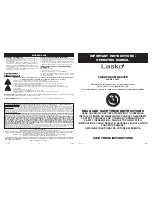
16
331432-001
INSTALLING THE NEW WATER HEATER
WATER PIPING
Water temperature over 52°C
(125°F) can cause severe
burns instantly resulting in
severe injury or death.
Children, the elderly and the
disabled and are at highest
risk of scald injury.
Feel water before bathing or
showering.
Temperature limiting devices
such as mixing valves must
be installed when required
by codes and to ensure safe
temperatures at fixtures.
BURN
HOT
HOT
DANGER
The water supply pressure should not exceed 80 psi. If this
occurs, a pressure reducing valve with a bypass should be
installed in the cold water inlet line. This should be placed
on the supply to the entire house in order to maintain equal
hot and cold water pressures.
HOT WATER CAN SCALD:
Water heaters are intended to produce hot water.
Water heated to a temperature which will satisfy space
heating, clothes washing, dish washing, cleaning and
other sanitizing needs can scald and permanently injure
you upon contact. Some people are more likely to be
permanently injured by hot water than others. These
include the elderly, children, the in
fi
rm, or physically/
mentally handicapped. If anyone using hot water
fi
ts into
one of these groups or if there is a local code or state law
requiring certain temperature water at the hot-water tap,
then you must take special precautions. In addition to
using lowest possible temperature setting that satis
fi
es
your hot water needs, a means such as a mixing valve,
should be used at hot-water taps used by these people
or at the water heater (see Figure 8 & Figure 9). Valves
for reducing point of use temperature by mixing cold and
hot water are also available.
SPACE HEATING AND POTABLE WATER SYSTEMS
This appliance has been design certi
fi
ed as complying
with American National Standard/CSA Standard for water
heaters and are considered suitable for Water (Potable)
Heating and Space Heating.
Note:
Water heaters used
in combination water/space heating shall not be used in
space heating only applications.
Toxic Chemical Hazard
WARNING
•
Do not connect to non-potable water system.
Consult a Quali
fi
ed Installer or Service Agency. Follow
manufacturer’s instructions for installation of valves.
Before changing the factory setting on thermostat, read
“Operating The Temperature Control System” section in
this manual.
•
This water heater should not be connected to any
heating systems or components previously used with
a non-potable water heating appliance.
•
All piping components connected to this unit for space
heating applications should be suitable for use with
potable water.
•
Toxic chemicals, such as those used for boiler treatment
shall not be introduced into the potable water used for
space heating.
•
When the system requires water for space heating at
temperatures higher than required for domestic water
purposes, a mixing valve must be installed. Please
refer to Figure 8 & Figure 9 for suggested piping
arrangement.
Note:
Water piping and vent piping occupy the space
above the water heater. Plan the water piping to ensure
it does not cause interference with the vent piping (see
“Planning The Vent System”).
If this water heater is to be used to supply both space
heating and potable water, the instructions listed below
must be followed:
•
Be sure to follow the manual(s) shipped with the air
handler or other type heating system.
•
This water heater is not to be used as a replacement
for an existing boiler installation.
•
Do not use with piping that has been treated with
chromates, boiler seal or other chemicals and do not
add any chemicals to the water heater piping.
•
If the space heating system requires water temperatures
in excess of 49°C (120°F), a mixing valve must be
installed, per the manufacturer’s instructions, in the
potable hot-water supply to limit the risk of scald injury.
•
Pumps, valves, piping and
fi
ttings must be compatible
with potable water.
•
A properly installed
fl
ow control valve is required to
prevent thermosiphoning. Thermosiphoning is the
result of a continuous
fl
ow of water through the air
handler circuit during the off cycle. Weeping (blow off)
of the temperature-pressure relief valve (T&P) or higher
than normal water temperatures are the
fi
rst signs of
thermosiphoning.
•
The hot-water line from the water heater should be
vertical past any mixing valve or supply line to the
heating system to remove air bubbles from the system.
•
Do not connect the water heater to any system or
components previously used with non-potable water
heating appliances when used to supply potable water.
















































